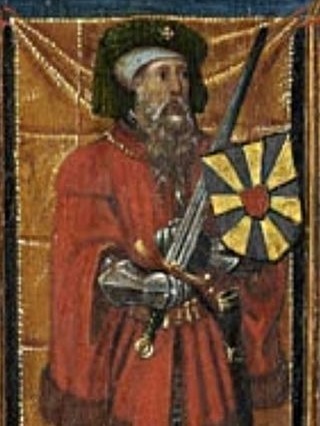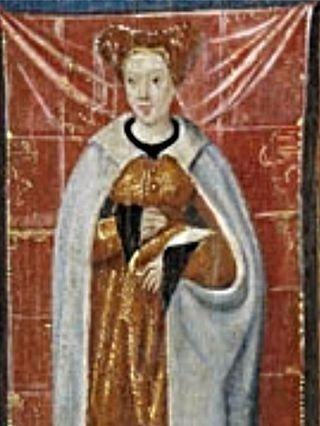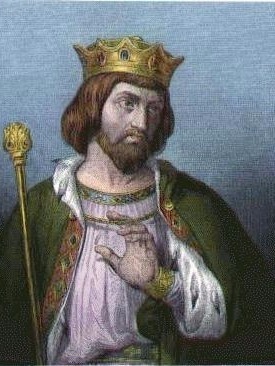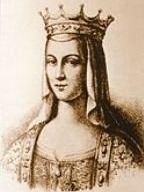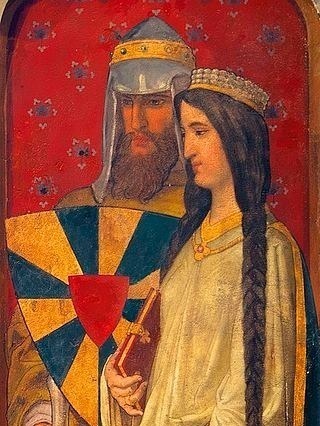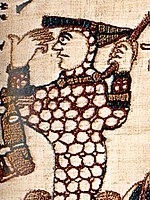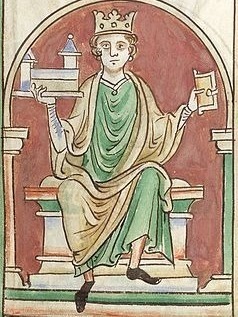Stamboom Snelder - Versteegh » Matilda of Flanders (1031-1083)
Persoonlijke gegevens Matilda of Flanders
Bron 1- Zij is geboren in het jaar 1031 in France.
- Zij is overleden op 2 november 1083, zij was toen 52 jaar oud.
- Een kind van Baldwin V of Flanders en Adèle of France
Gezin van Matilda of Flanders
Zij heeft/had een relatie met William "the Conqueror" of England.
Kind(eren):
Notities over Matilda of Flanders
https://en.wikipedia.org/wiki/Matilda_of_Flanders
Matilda of Flanders (French: Mathilde; Dutch: Machteld) (c. 1031 – 2 November 1083) was Queen of England and Duchess of Normandy by marriage to William the Conqueror, and sometime Regent of these realms during his absence. She was the mother of ten children who survived to adulthood, including two kings, William II and Henry I.
As a niece and granddaughter of kings of France, Matilda was of grander birth than William, who was illegitimate, and, according to some suspiciously romantic tales, she initially refused his proposal on this account. Her descent from the Anglo-Saxon royal House of Wessex was also to become a useful card. Like many royal marriages of the period, it breached the rules of consanguinity, then at their most restrictive (to seven generations or degrees of relatedness); Matilda and William were third-cousins, once removed. She was about 20 when they married in 1051/2; William was some four years older, and had been Duke of Normandy since he was about eight (in 1035).
The marriage appears to have been successful, and William is not recorded to have had any bastards. Matilda was about 35, and had already born most of her children, when William embarked on the Norman conquest of England, sailing in his flagship Mora, which Matilda had given him. She governed the Duchy of Normandy in his absence, joining him in England only after more than a year, and subsequently returning to Normandy, where she spent most of the remainder of her life, while William was mostly in his new kingdom. She was about 52 when she died in Normandy in 1083.
Apart from governing Normandy and supporting her brother's interests in Flanders, Matilda took a close interest in the education of her children, who were unusually well educated for contemporary royalty. The boys were tutored by the Italian Lanfranc, who was made Archbishop of Canterbury in 1070, while the girls learned Latin in Sainte-Trinité Abbey in Caen, founded by William and Matilda as part of the papal dispensation allowing their marriage.
Matilda, or Maud, was the daughter of Baldwin V, Count of Flanders, and Adela, herself daughter of King Robert II of France.[1]
According to legend, when the Norman duke William the Bastard (later called the Conqueror) sent his representative to ask for Matilda's hand in marriage, she told the representative that she was far too high-born to consider marrying a bastard.[a] After hearing this response, William rode from Normandy to Bruges, found Matilda on her way to church, dragged her off her horse by her long braids, threw her down in the street in front of her flabbergasted attendants and rode off.
Another version of the story states that William rode to Matilda's father's house in Lille, threw her to the ground in her room (again, by her braids) and hit her (or violently battered her) before leaving. Naturally, Baldwin took offence at this; but, before they could draw swords, Matilda settled the matter[2] by refusing to marry anyone but William;[3] even a papal ban by Pope Leo IX at the Council of Reims on the grounds of consanguinity did not dissuade her. William and Matilda were married after a delay in c. 1051–2.[4] A papal dispensation was finally awarded in 1059 by Pope Nicholas II.[5] Lanfranc, at the time prior of Bec Abbey, negotiated the arrangement in Rome and it came only after William and Matilda agreed to found two churches as penance.[6]
There were rumours that Matilda had been in love variously with the English ambassador to Flanders and with the great Saxon thegn Brictric, son of Algar, who (according to the account by the Continuator of Wace and others[7]) in his youth declined her advances. Whatever the truth of the matter, years later when she was acting as regent for her husband William in England, she is said to have used her authority to confiscate Brictric's lands and throw him into prison, where he died.[8]
When William was preparing to invade England, Matilda outfitted a ship, the Mora, out of her own funds and gave it to him.[9] Additionally, William gave Normandy to his wife during his absence. Matilda successfully guided the duchy through this period in the name of her fourteen-year-old son; no major uprisings or unrest occurred.[10]
Even after William conquered England and became its king, it took her more than a year to visit the kingdom.[11] Despite having been crowned queen, she spent most of her time in Normandy, governing the duchy, supporting her brother's interests in Flanders, and sponsoring ecclesiastic houses there. Only one of her children was born in England; Henry was born in Yorkshire when Matilda accompanied her husband in the Harrying of the North.[12]
Matilda was crowned queen on 11 May 1068 in Westminster during the feast of Pentecost, in a ceremony presided over by the archbishop of York. Three new phrases were incorporated to cement the importance of English consorts, stating that the Queen was divinely placed by God, shares in royal power, and blesses her people by her power and virtue.[13][14]
For many years it was thought that she had some involvement in the creation of the Bayeux Tapestry (commonly called La Tapisserie de la Reine Mathilde in French), but historians no longer believe that; it seems to have been commissioned by William's half-brother Odo, Bishop of Bayeux, and made by English artists in Kent.[15]
Matilda bore William nine or ten children. He was believed to have been faithful to her and never produced a child outside their marriage. Despite her royal duties, Matilda was deeply invested in her children's well-being. All were known for being remarkably educated. Her daughters were educated and taught to read Latin at Sainte-Trinité in Caenfounded by Matilda and William in response to the recognition of their marriage.[16] For her sons, she secured Lanfranc, Archbishop of Canterbury of whom she was an ardent supporter. Both she and William approved of the Archbishop's desire to revitalise the Church.[17]
She stood as godmother for Matilda of Scotland, who would become Queen of England after marrying Matilda's son Henry I. During the christening, the baby pulled Queen Matilda's headdress down on top of herself, which was seen as an omen that the younger Matilda would be queen some day as well.[18]
Matilda fell ill during the summer of 1083 and died in November 1083. Her husband was present for her final confession.[19] William died four years later in 1087.
Contrary to the common belief that she was buried at St. Stephen's, also called l'Abbaye-aux-Hommes in Caen, Normandy, where William was eventually buried, she is entombed in Caen at l'Abbaye aux Dames, which is the community of Sainte-Trinité. Of particular interest is the 11th-century slab, a sleek black stone decorated with her epitaph, marking her grave at the rear of the church. In contrast, the grave marker for William's tomb was replaced as recently as the beginning of the 19th century.
Over time Matilda's tomb was desecrated and her original coffin destroyed. Her remains were placed in a sealed box and reburied under the original black slab.[20] In 1959 Matilda's incomplete skeleton was examined and her femur and tibia were measured to determine her height using anthropometric methods. Her height was 5 feet (1.52m), a normal height for the time.[21] However, as a result of this examination she was misreported as being 4 feet 2 inches (1.27m)[22] leading to the myth that she was extremely small.
Matilda and William had four sons and at least five daughters.[23] The birth order of the boys is clear, but no source gives the relative order of birth of the daughters.[23]
- Robert, born between 1051 and 1054, died 10 February 1134.[24] Duke of Normandy, married Sybil of Conversano, daughter of Geoffrey of Conversano.[25]
- Richard, born c. 1054, died around 1075.[24]
- William Rufus, born between 1056 and 1060, died 2 August 1100.[24] King of England, killed in the New Forest.
- Henry, born late 1068, died 1 December 1135.[24] King of England, married Edith of Scotland, daughter of Malcolm III of Scotland. His second wife was Adeliza of Louvain.[26]
- Agatha, betrothed to Harold II of England, Alfonso VI of Castile, and possibly Herbert I, Count of Maine, but died unmarried.[b][27]
- Adeliza (or Adelida,[28] Adelaide[26]), died before 1113, reportedly betrothed to Harold II of England, probably a nun of St Léger at Préaux.[28]
- Cecilia (or Cecily), born c. 1056, died 1127. Abbess of Holy Trinity, Caen.[27]
- Matilda,[28] "daughter of the King", born around 1061, died perhaps about 1086,[26] or else much later (according to Trevor Foulds's suggestion that she was identical to Matilda d'Aincourt[29]).
- Constance, died 1090, married Alan IV Fergent, Duke of Brittany.[27]
- Adela, died 1137, married Stephen, Count of Blois.[27] Mother of King Stephen of England.
There is no evidence of any illegitimate children born to William.[30]
William was furious when he discovered she sent large sums of money to their exiled son Robert.[31] She effected a truce between them at Easter 1080.
Tijdbalk Matilda of Flanders
 grootouders
grootouders
 ouders
ouders
 broers/zussen
broers/zussen
 kinderen
kinderen
Voorouders (en nakomelingen) van Matilda of Flanders
Matilda of Flanders 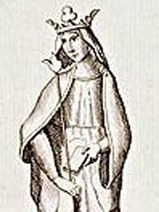 | |||||||||||||||||||||||||||||||||||
William "the Conqueror" of England | |||||||||||||||||||||||||||||||||||
Verwantschap Matilda of Flanders
- Matilda of Flanders is de achter(x46)kleindochter van Titus Manlius Imperiosus Torquatus:Titus Manlius Imperiosus TorquatusTitus Manlius TorquatusTitus Manlius TorquatusAulus Manlius TorquatusTitus Manlius TorquatusDecimus Junius Silanus ManlianusMarcus Junius Silanus consulMarcus Junius SilanusMarcus Junius Silanus consulMarcus Junius SilanusJunia Calvina EquitusGaius SallustiusGaius Ummidius Quadratus SallustiusGaius Ummidius Quadratus Annianus VerusGaius Ummidius Quadratus Annianus Verus FulviusUmmidia Commificia AntoniaPendania Pedanius FuscusMariana MinorAurelia PompeianaClaudiaConstantius I Chlorus of RomeUnkownProcopius UsurperProcopiusProcopius II Magister Militum of ByzantiumProcopius Anthemius I of the of the Western Roman EmpireAlypia Princess of the of RomeCaratene Agrippina of NarbonneClothilde of BurgundyChlothar I of the FranksCharibert I of ParisBilichildeArnoald of MetzDodaAnsegisel of the FranksPepin II of HerstalCharles Martel of the FranksPepin The Short III of the FranksCharlemange (Charles I) of the FranksLouis I the Pious de Aquitaine of FranceCharles the BaldJudith of Flanders Princess of Holy Roman 1st Countess of FlandersBaldwin II of FlandresArnulf I of FlandersBaldwin III of FlandersArnulf II of FlandersBaldwin IV of FlandersBaldwin V of FlandersMatilda of Flanders
Bronnen
- Biographical Summaries of Notable People, via https://www.myheritage.nl/research/colle...
Matilda of FlandersGeslacht: VrouwGeboorte: 1031 - FranceOverlijden: 2 nov 1083 Familieleden: RelatieNaamGeboorteVaderBaldwin V, Count of Flanders19 aug 1012MoederAdèle of France, Countess of Flanders1009ZoonWilliam II of England1056ZoonHenry I of Englandsep 1068ZoonRobert Curthose1050DochterAdela of Normandy1067ZoonRichard of NormandyDochterAgatha of NormandyDochterConstance of NormandyDochterCecilia of NormandyDochterAdelizaEchtgenootWilliam The Conqueror1028
The records in this collection vary in what data items are present and one will find information on various aspects of the subject persons including names, biographical descriptions, nationalities, birth dates, birth places, death dates, death places, relatives, spouses, children, professions, nationalities, and educational attainment. The information in this collection has been compiled from Freebase (under CC-BY) and Wikipedia (under the GNU Free Documentation License).
Aanknopingspunten in andere publicaties
Deze persoon komt ook voor in de publicatie:Dezelfde geboorte/sterftedag
- 1148 » Malachias (53/54), Iers bisschop van Armagh
- 1868 » Carl Henrik Boheman (72), Zweeds entomoloog
- 1915 » Isaac Rice (65), Amerikaans ondernemer en schaker
- 1922 » Ananias Diokno (62), Filipijns generaal
- 1924 » Kai Nielsen (41), Deens beeldhouwer
- 1925 » Antoon Derkinderen (65), Nederlands schilder en ontwerper
Over de familienaam Of Flanders
- Bekijk de informatie die Genealogie Online heeft over de familienaam Of Flanders.
- Bekijk de informatie die Open Archieven heeft over Of Flanders.
- Bekijk in het Wie (onder)zoekt wie? register wie de familienaam Of Flanders (onder)zoekt.
Roel Snelder, "Stamboom Snelder - Versteegh", database, Genealogie Online (https://www.genealogieonline.nl/stamboom-snelder-versteegh/I506917.php : benaderd 7 mei 2024), "Matilda of Flanders (1031-1083)".
